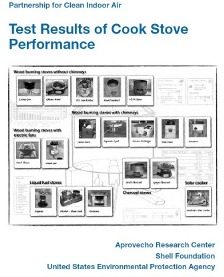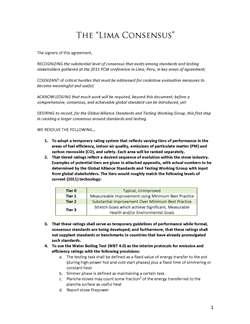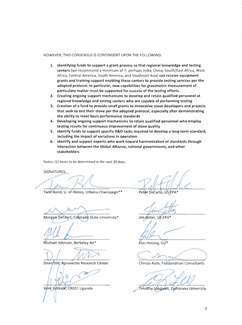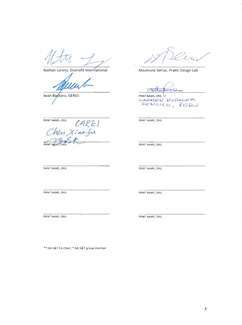The following standard protocols for stove performance tests were developed by Volunteers in Technical Assistance (VITA, 1985, Testing the Efficiency of Wood-burning Cookstoves: Provisional International Standards), and updated by the Household Environment and Health (HEH) Project, funded by the Shell Foundation.
Stove Testing
Please note, the PCIA website is now a legacy site. The resources that were produced over the past 10 years of the Partnership are still accessible on this website. However, the content is no longer being updated as of June 1, 2012.
Stove performance varies greatly, and the performance of a specific stove is often different in the lab and in the field. Testing allows implementers to learn how well stoves perform and to quantify improvements in fuel efficiency and emissions. Test results can be used to guide implementation decisions and to improve stove design and performance. Below is a collection of stove testing resources that may be of interest to PCIA Partners.
Water Boiling Test (WBT)
The Water Boiling Test (WBT) is a laboratory test that evaluates stove performance while completing a standard task (boiling and simmering water) in a controlled environment to investigate the heat transfer and combustion efficiency of the stove. They are the easiest, quickest, and cheapest to conduct, but reveal the technical performance of a stove, not necessarily what it can achieve in real households.
The Water Boiling Test (WBT) Version 4 was open for public comment from October 15 – December 18, 2009 and is still under review. To read the comments received, please visit ../..//testing/wbtcomment.
Correction Notice: A corrected version of the WBT data calculation spreadsheet 4.1.2 has been posted as of June 19, 2012. If you downloaded the data calculation spreadsheet on or before June 19th, please download this corrected version.
| Attachment | Size |
|---|---|
| WBT_Version_3.0.pdf | 629.19 KB |
| WBT_data-calculation_sheet_3.0.xls | 174 KB |
| WBT_data_entry_forms.pdf | 78.5 KB |
| WBT4.1.2_0.pdf | 791.05 KB |
| WBT_data-calculation-sheet_4.1.2_updated_19-Jun-2012.xls | 279 KB |
Controlled Cooking Test (CCT)
The Controlled Cooking Test (CCT) is a field test that measures stove performance in comparison to traditional cooking methods when a cook prepares a local meal. The CCT is designed to assess stove performance in a controlled setting using local fuels, pots, and practice. It reveals what is possible in households under ideal conditions but not necessarily what is actually achieved by households during daily use.
| Attachment | Size |
|---|---|
| CCT_Version_2.0.pdf | 500.92 KB |
| CCT_data-calculation_sheet_2.0.xls | 167.5 KB |
Kitchen Performance Test (KPT)
The Kitchen Performance Test (KPT) is a field test used to evaluate stove performance in real-world settings. It is designed to assess actual impacts on household fuel consumption. KPTs are typically conducted in the course of an actual dissemination effort with real populations cooking normally, and give the best indication of real world changes.
Correction: The original version of the KPT data collection spreadsheet posted here contained an error. The dry wood per capita calculation on the wood and non-woody biomass sheets had the wet wood per capita as the denominator instead of adult equivalents. A corrected version of the spreadsheet was posted below on June 16, 2010. The PCIA Coordination Team apologizes for any inconvenience.
| Attachment | Size |
|---|---|
| KPT_Version_3.0.pdf | 527.12 KB |
| KPT_data-calculation_sheet_3.0.xls | 137.5 KB |
Safety Guidelines and Testing
A set of safety guidelines and testing procedures was developed by Nathan Johnson from Iowa State University (with collaboration from various PCIA Partners)as part of his masters thesis "Risk Analysis and Safety Evaluation of Household Stoves in Developing Nations." The attached document (Chapter 5 from his thesis) provides standardized methods of testing stove safety to minimize the harmful factors of stove use. The full document can be found at http://www.vrac.iastate.edu/~atlas/safety.htm.
| Attachment | Size |
|---|---|
| Stove-Testing-Safety-Guidelines.pdf | 441.93 KB |
| Summarized-Safety-Procedures.pdf | 71.6 KB |
Test Results of Cook Stove Performance
 |
The Partnership for Clean Indoor Air is pleased to make available a new publication entitled "Test Results of Cook Stove Performance." This document was developed by Aprovecho Research Center under a grant from the Shell Foundation to provide technical support to household energy and health projects and to ensure that the projects’ designs represent the best available technical practices. Test Results of Cook Stove Performance represents a major step forward in developing an integrated approach to cook stove design. For the first time, a variety of stoves from across the world have been tested in a variety of ways and the results presented here for all to review.
Click HERE to view the Test Results of Cook Stove Performance document.
Please note -- due to file size the document may take a few moments to load on your computer.
Lima Consensus on Stove Performance Rating
   |
At the 2011 PCIA Forum, many stakeholders participated in the development of, or signed on to, the Lima Consensus, an agreement to establish an interim rating system for the evaluation of cookstove models “that reflects the varying tiers of performance in the areas of fuel efficiency, indoor air quality, emissions of particulate matter and carbon monoxide, and safety.”
This agreement, an important step along the path toward developing voluntary global cookstove standards, was developed by members of the Global Alliance Standards and Technology Working Group, led by Tami Bond and Morgan DeFoort, and other stove testing leaders to recognize the areas of consensus among the standards and testing stakeholders gathered at the PCIA Forum. The group also recognized some of the challenges to address to make cookstove evaluation measures increasingly meaningful and useful and acknowledges that more work is required before a comprehensive, consensus and achievable global standard can be introduced.
In addition, a methodology was identified for rating of indoor air pollution. When finalized, the rating system will be fuel and stove neutral, simply rating stove/fuels by a number of criteria that will enable our community to have a better understanding of the performance of existing stove models and drive innovation to improve stove performance.
You can download the full signed consensus as well as the PCIA Forum Presentation below.
| Attachment | Size |
|---|---|
| Lima_Consensus_Signed.pdf | 97.03 KB |
| Saturday_Lima_Consensus.pdf | 210.48 KB |
Stove Testing Centers
A number of stove testing centers are available worldwide that are skilled in conducting stove performance testing to evaluate fuel consumption, energy efficiency, power and emissions. Below is a list of testing centers and links to their Profiles for more information:
North America
Aprovecho Research Center - United States
Colorado State University Engines and Energy Conversion Lab - United States
Africa
Centre for Research in Energy and Energy Conservation (CREEC)/Makerere University - Uganda
Sustainable energy Technology And Research Centre (SeTAR) - South Africa
Asia
Asia Regional Cookstove Program (ARECOP) - Indonesia
China Agricultural University Energy Engineering and Low Carbon Technology Lab (EELC)/Renewable Resources Lab (RRL) - China
GERES - Cambodia
Prakti Design Lab - India
Latin America
GIZ - Bolivia - Bolivia
SENCICO - Peru
Zamorano University - Honduras
